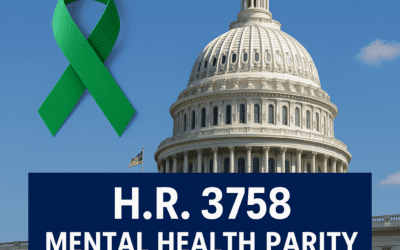In Ariana M v. Humana Health Plan of Texas, Inc., 2018 WL 1096980 (5th Cir. March 1, 2018), a divided Fifth Circuit issued an en banc ruling that finally overturned Pierre v. Conn. Gen. Life Ins. Co., 932 F.2d 1552 (5th Cir. 1991) and concurred with every other Circuit that Firestone Tire & Rubber Co. v. Bruch, 489 U.S. 101 (1989) applies the default de novo standard of judicial review to both legal and factual determinations, thus paving the way for the Texas ban on discretionary clauses (TEX. INS. CODE § 1701.062(a), along with similar bans by 25 other states – Nat’l Ass’n of Ins. Comm’rs, Prohibition on the Use of Discretionary Clauses Model Act ST-42-3-6 (2014), http://www.naic.org/store/free/MDL-42.pdf.) to trigger de novo review of benefit denials of health and disability benefit claims.
The underlying case involved a claim for health insurance reimbursement brought on behalf of a patient who suffered from a severe eating disorder who had over 100 self-inflicted cuts over her body when admitted to a treatment facility. Humana determined that only a portion of the treatment was medically necessary based on file reviews performed by two doctors who maintained the patient was “stable.” After pre-litigation appeals failed to overturn Humana’s denial, the plaintiff filed an action pursuant to 29 U.S.C. § 1132(a)(1)(B) to recover benefits claimed to be due.
Although the policy contained a clause granting Humana discretion to render benefit eligibility determinations, the plaintiff argued that the Texas ban on the inclusion such clauses in health insurance policies invalidated the insurer’s discretionary authority. The court agreed, but held that Human’s evidentiary findings were still reviewed under an abuse of discretion standard pursuant to Pierre. Applying that standard, the court concluded Humana’s determination was reasonable and upheld the benefit denial. The court of appeals was compelled to affirm; however, the court agreed to review the continued vitality of Pierre in an en banc hearing.
The court began its discussion of the Texas law banning discretionary clauses. It noted that the law made such clauses unenforceable, but did not attempt to prescribe standard of judicial review. The court further pointed out that Humana did not even argue that the Texas law was preempted, although it noted several appellate rulings finding that similar laws were not ERISA-preempted. Fontaine v. Metro. Life Ins. Co., 800 F.3d 883, 891 (7th Cir. 2015); Standard Ins. Co. v. Morrison, 584 F.3d 837, 842-45 (9th Cir. 2009); Am. Council of Life Insurers v. Ross, 558 F.3d 600, 604-09 (6th Cir. 2009).
The court then turned to the question of whether Pierre should be overturned. The court acknowledged that no other circuit agreed with the Fifth Circuit that Firestone’s default de novo standard was limited to the power to interpret plan terms. Indeed, most of the circuits that addressed Pierre rejected its reading of Firestone and held that the de novo standard applied to both factual and legal determinations. In re-reading Firestone, the court acknowledged the Supreme Court’s language “suggests Firestone was articulating a general default standard of review for Section 1132(a)(1)(B) actions–the provision that allows judicial review of benefit denials–rather than making the fine distinction Pierre saw between the review of factual determinations and legal interpretations.”
The court also observed that the purported reliance on trust law for drawing a factual/legal dichotomy was misplaced. Indeed, under trust law, there is a presumption of deference unless the trust document says otherwise. Firestone flipped the default principle. The court further remarked,
A leading trust scholar left no doubt of what he thought about Firestone‘s reading of trust law. See John H. Langbein, The Supreme Court Flunks Trusts, 1990 SUP. CT. REV. 207. Professor Langbein explained that the Supreme Court reversed the traditional trust-law presumption that assumed “[t]he trustee ha[d] discretion unless the instrument or some particular doctrine of trust law denies discretion.” Id. at 219. Despite his sharp critique of the Supreme Court’s reading of trust law, Professor Langbein believes the Court correctly adopted de novo review in light of “the regulatory purposes of ERISA.” John H. Langbein, Trust Law as Regulatory Law: The UNUM/Provident Scandal and Judicial Review of Benefit Denials Under ERISA, 101 NW. U. L. REV. 1315, 1323 n.47 (2007). Of course, regardless of whether Firestone was right or wrong in setting a default de novo standard, we are bound to apply it.
Moreover, the court rejected Pierre’s analogy to the deference reviewing courts afford agency decisions and trial court findings because “agencies and trial judges are required to apply a developed set of constitutional and statutory procedural protections. They are also impartial whereas a plan administrator often has an incentive to reach decisions ‘advantageous to its own interests.'” (citations omitted). Further, the court found from empirical experience that a regime of de novo judicial review has not increased the time and expense of ERISA litigation, while “[a]buse-of-discretion cases frequently result in litigation about the existence and extent of a conflict of interest, which is one of the rare areas in which a plaintiff can often expand the administrative record with discovery.” Finally, more recent Supreme Court decisions have offered no support to the notion of a legal/factual dichotomy; and in the interest of maintaining uniformity among ERISA, the en banc majority quoted the Three Dog Night song lyric that says “one really is the loneliest number.”
However, despite changing the standard of ERISA court review, the court held that the scope of review of ERISA cases would remain undisturbed and that review would be limited to the record. Following Vega v. National Life Insurance Services, Inc., 188 F.3d 287 (5th Cir. 1999) (en banc), overruled on other grounds by Metro. Life Ins. Co. v. Glenn, 554 U.S. 105, 128 S.Ct. 2343, 171 L.Ed.2d 299 (2008), the scope of review would be limited to the claim record with limited exceptions:
One exception allows a district court to admit evidence to explain how the administrator has interpreted the plan’s terms in previous instances. Id. (citing Wildbur v. ARCO Chem. Co., 974 F.2d 631, 639 n.15 (5th Cir. 1992)). Another allows a district court to admit evidence, including expert opinions, to assist in the understanding of medical terminology related to a benefits claim. Id. Those situations are not actually expanding the evidence on which the merits are evaluated but providing context to help the court evaluate the administrative record.
There were several dissenting opinions, including one authored by E. Grady Jolly, who had written Pierre, and which was joined in by Edith Jones, who was a concurring judge on the Pierre panel.
Discussion: This ruling was long in coming. Pierre was based on an apparent misreading of Firestone and the Fifth Circuit stubbornly adhered to it despite criticism from other circuits. However, while the ruling on the standard of review was entirely correct, the ruling on the scope of review was ill considered. The notion that ERISA claims are to be conducted as review proceedings is based on an erroneous premise. As the Seventh Circuit explained, “All in all, it would be best for judges and lawyers to stop thinking about ‘de novo review’–with the implication that the judge is ‘reviewing’ someone else’s action–and start thinking about independent decision, which is what Firestone requires.” Krolnik v. Prudential Ins. Co. of Am., 570 F.3d 841, 844 (7th Cir. 2009).
Krolnik is plainly the correct view with respect to the scope of a court’s consideration of an ERISA claim under the de novo standard since the ERISA statute affords benefit claimants the right to bring a “civil action” to enforce their rights under the statute. 29 U.S.C. § 1132(a). That phrase is a term that has repeatedly been interpreted by the Supreme Court to invoke the right to a plenary hearing rather than a review proceeding. In Chandler v. Roudebush, 425 U.S. 840 (1976), which resolved a circuit split on whether a federal employee had a right to a trial in a discrimination suit, the Supreme Court explained:
In most instances, of course, where Congress intends review to be confined to the administrative record, it so indicates, either expressly or by use of a term like “substantial evidence,” which has “become a term of art to describe the basis on which an administrative record is to be judged by a reviewing court.” Ibid. E. g., 5 U.S.C. § 706 (scope-of-review provision of Administrative Procedure Act); 12 U.S.C. § 1848 (scope-of-review provision applicable to certain orders of the Board of Governors of the Federal Reserve System); 15 U.S.C. § 21 (c) (scope-of-review provision applicable to certain orders of the Interstate Commerce Commission, the Federal Communications Commission, the Civil Aeronautics Board, the Federal Reserve Board, and the Federal Trade Commission); 21 U.S.C. § 371 (f)(3) (scope-of-review provision applicable to certain orders of the Secretary of Health, Education, and Welfare).
425 U.S. at 862 n.37. Since the ERISA statute does not contain any reference to substantial evidence or use other terminology that would typically be associated with administrative law, the notion that ERISA cases are review proceedings is erroneous.
As further support, in United States v. First City National Bank, 386 U.S. 361 (1967), the Court examined the standards to be applied by a court in a judicial proceeding challenging a bank merger. One applicable statutory provision prescribed: “In any such action [to challenge a bank merger], the court shall review de novo the issues presented.” The Supreme Court rejected a reading of that provision that would trigger a review proceeding, noting:
It is argued that the use of the word “review” rather than “trial” indicates a more limited scope to judicial action. The words “review” and “trial” might conceivably be used interchangeably. The critical words seem to us to be “de novo” and “issues presented.” They mean to us that the court should make an independent determination of the issues.
386 U.S. at 368.
Even more recently, in Kappos v. Hyatt, 132 S.Ct. 1690 (2012), a case that dealt with lawsuits challenging patent denials, the Court ruled that the district court was required to serve as a factfinder, which “must make its own findings de novo” rather than act as a “reviewing court” as envisioned by the Administrative Procedures Act. 132 S.Ct. at 1696.
Finally, denying claimants the right to trial is inconsistent with the Supreme Court’s admonition in Firestone Tire & Rubber Co. v. Bruch, 489 U.S. 101, 114 (1989) that ERISA’s passage was never intended to afford “less protection to employees and their beneficiaries than they enjoyed before ERISA was enacted.” Firestone Tire & Rubber Co. v. Bruch, 489 U.S. 101, 114 (1989). Prior to ERISA’s passage, litigation involving group disability benefits was resolved through trials. See, e.g., Cox v. Washington Natl. Insur.Co., 520 S.W.2d 76 (Ct.App.Mo. 1974)(employer sponsored disability benefit claim accorded plenary civil procedure); Antram v. Stuyvesant Life Insur.Co., 287 So.2d 837 (Ala. 1973)(same). Thus, confining ERISA cases adjudicated under the de novo standard to review proceedings is an error that needs to be rectified.






